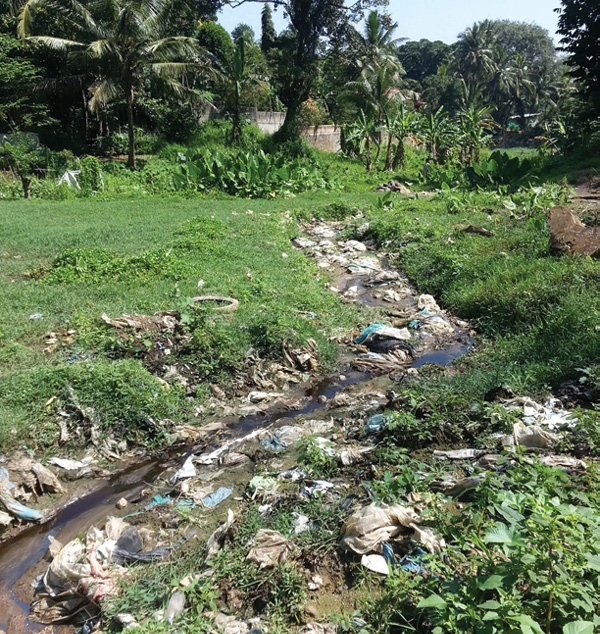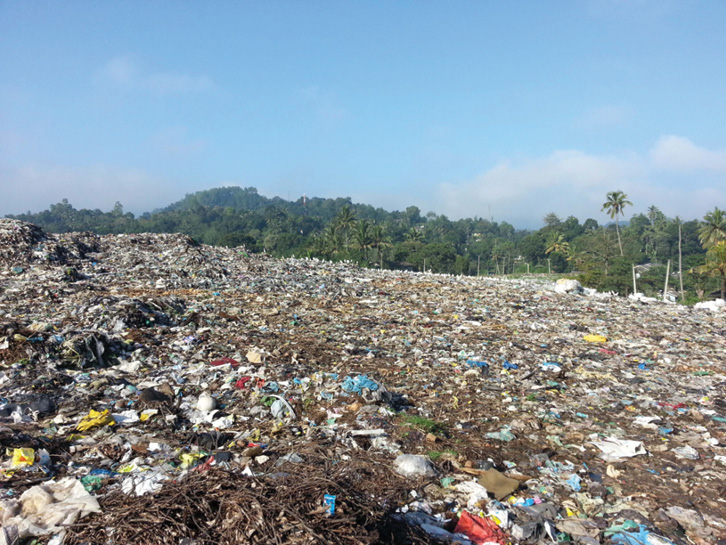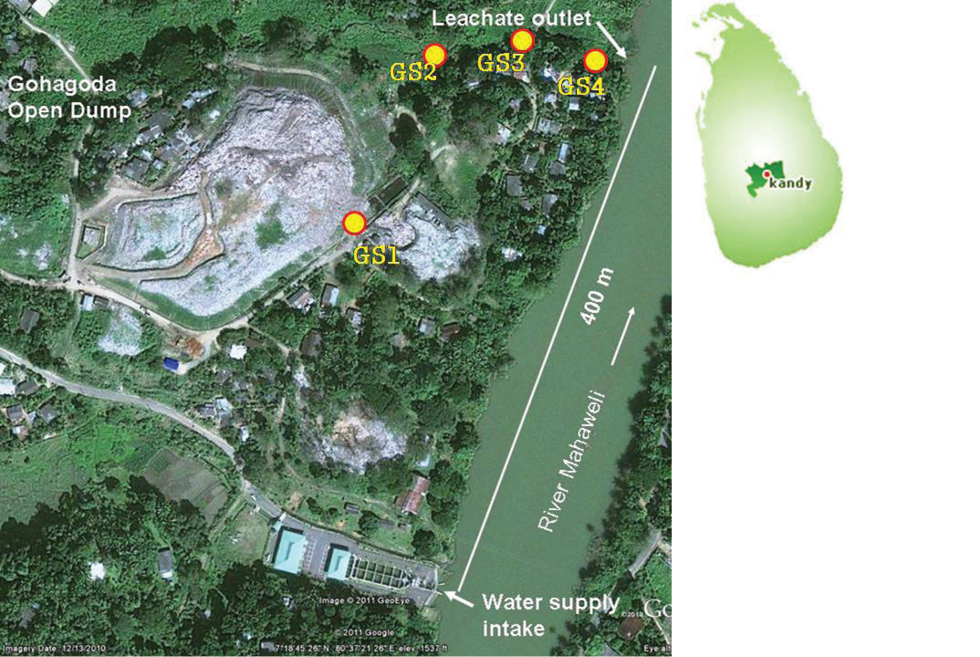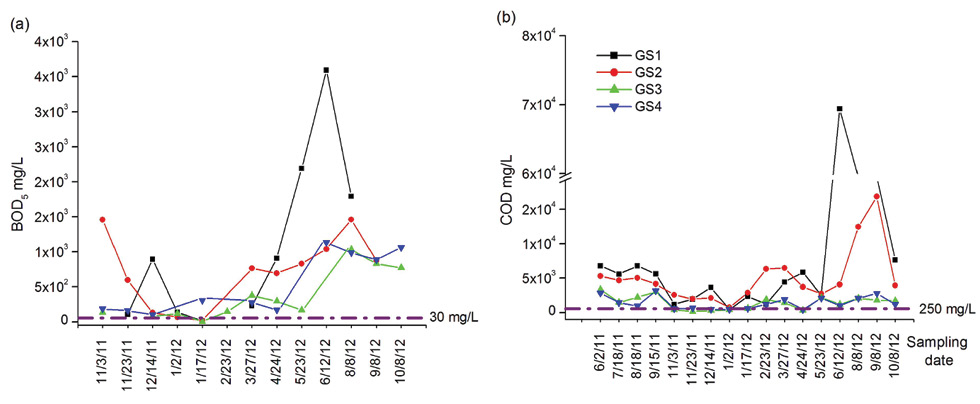Uncontrolled population growth, rapid urbanisation, the rise in community living standards and poor planning have accelerated the rate of generation of municipal solid waste (MSW) in Sri Lanka. Waste is ending up in open dump sites and, subsequently, water sources. Drinking water quality is a significant determinant of health; hence, water quality deterioration causes health, social and economic problems.
MSW management is one of the biggest challenges of the 21st century. Whereas developed countries consider how MSW affects the environment, most developing countries, including Sri Lanka, use open dumping to dispose of MSW, which can pollute the environment. Open dumping of waste with high organic content further aggravates pollution problems, because large amounts of highly contaminated liquid leachate are formed. Leachate is one of the major sources of toxic metals, organic carbon compounds and nitrogenous compounds that can contaminant the environment, including water bodies that supply drinking water.1,2

A contaminated waterway in Sri Lanka

A municipal solid waste site in Sri Lanka
Wealth to waste: waste load and composition
Sri Lanka is an island in the Indian Ocean, with a total area of 65 525 km2 and a population of 20.2 million. At present, average solid waste generation in Sri Lanka is 6500–9000 tonnes/day. Recent studies show that the waste generation rate in most urban parts of Sri Lanka is close to 1 kg/person/day.3 Dump sites have no weighing facilities; hence, there are no proper records on MSW generation, and all data are estimates. More than 60% of the MSW in Sri Lanka is organic matter, and paper (12%), wood (10%), plastic (7%), metal (4%) and glass (3%) make up the rest.4
Uncontrolled dumping resulted in a devastating MSW slide at one of the largest dumps in Colombo (Meetotamulla), which buried around 300 people in April 2017.
Waste to water: landfill leachate
Leachate mainly forms when rain percolates through the surface of, and into, the material in a landfill. Hence, more leachate is formed during periods of high rainfall. In addition, the moisture content of waste influences the amount of leachate generated from a dump site. MSW landfill leachates are variable and complex materials, reflecting the composition of solids dumped in the landfill. It is a common source of many contaminants, and MSW leachates often have high concentrations of:
- heavy metals (eg lead, cadmium, nickel, chromium, zinc, manganese, copper and iron)
- dissolved organic carbon components (eg humic, fulvic and hydrophilic acids)
- inorganic ions (eg NO3–, NH4+, NO2–, PO43–, SO43– and Cl–)
- xenobiotic organic compounds (eg halogenated hydrocarbons, aromatic hydrocarbons, phenols, benzene and chlorinated aliphatics).
The characterisation of the landfill leachate plays an important role when determining the treatment method. Landfill leachate in the humid tropics may differ from that in temperate and arid regions,2 and there may be different chemical components, stemming from different consumer waste patterns. Most leachate characterisation studies are for developed countries. Thus, we have characterised the landfill leachate from a major dump site in Sri Lanka – the Gohagoda open dump site.
End point of leachate: polluted drinking water
Study site: Gohagoda open dump site
The city of Kandy has been sending its waste to the Gohagoda open dump site since the 1960s.5 Currently, about 130 tonnes of MSW are being dumped per day, without any sorting or pretreatment. Waste comes from slaughter houses, fish markets, households and hospitals. The amount of leachate produced at Gohagoda is estimated to be 30 304 m3/year. Untreated leachate flows from the dump site through the existing drainage channel and adjoining lands, directly into the River Mahaweli, the largest river in Sri Lanka. This could lead to adverse environmental and health effects for the people in nearby urban areas using the river as a water supply.
We collected landfill leachate from the Gohagoda site from June 2011 to October 2012 from 4 sampling points of the leachate drainage channel. GS1 and GS4 were at the starting and end points of the channel, and the GS2 and GS3 points were in the middle (Figure 1).


Results
The analytical results for many parameters such as biochemical oxygen demand (BOD5), chemical oxygen demand (COD), pH and level of ammonium nitrogen show that many old landfills across the world produce similar leachate (Table 1). The BOD5 and COD values for Gohagoda are almost 50 times and 10 times higher than the permissible levels for wastewater, respectively (Figure 2). Gohagoda leachate is rich in volatile organic compounds such as phenol, xylene and benzene, which are carcinogenic and mutagenic to human cells.
The demonstrated values for concentrations of ammonium nitrogen, phosphate, solids and some heavy metals were much higher than Sri Lanka’s permissible levels for wastewater discharge (Table 1). Even though some parameters were below the permissible values, extensive pollution is still occurring due to cumulative discharge to the river every year.
| Constituent | Gohagoda leachatea | Acetogenic leachatesb | Methanogenic leachatesb | CEA standards | |
|---|---|---|---|---|---|
| GS1 | GS4 | ||||
|
pH |
8.12 |
8.16 |
5.5–7.0 |
7.5–8.5 |
6.0–8.5 |
|
BOD5 (mg/L) |
1090 |
528 |
4000–30 000 |
<500–1000 |
30 |
|
COD (mg/L) |
13 248 |
1425 |
10 000–50 000 |
2000–6000 |
250 |
|
TSS (mS/cm) |
1730 |
126 |
na |
na |
50 |
|
Alkalinity (mg/L) |
8890 |
2589 |
2000–10 000 |
10 000–30 000 |
na |
|
Ammonia nitrogen (mg/L) |
1113 |
330 |
750–2000 |
1500–3000 |
50 |
|
Nitrate nitrogen (mg/L) |
128 |
32 |
<1 |
<1 |
na |
|
Phosphate (mg/L) |
107 |
54 |
5–20 |
1000–3000 |
5 |
|
Chromium (mg/L) |
0.13 |
0.09 |
<0.1–0.1 |
<0.3–2.0 |
0.1 |
|
Lead (mg/L) |
0.18 |
0.14 |
<0.1–<0.5 |
<0.05–0.20 |
0.1 |
|
Zinc (mg/L) |
1.15 |
0.3 |
5–20 |
<0.01–0.05 |
5 |
|
Nickel (mg/L) |
0.33 |
0.11 |
<0.1–<1.0 |
<0.05–0.10 |
0.1 |
|
Cadmium (mg/L) |
0.40 |
0.01 |
<0.1–<0.2 |
<0.02–0.01 |
0.1 |
BOD = biochemical oxygen demand; CEA = Central Environmental Authority; COD = chemical oxygen demand; na = not applicable; TSS = total suspended solids a Annual average value b Data from Robinson 20072

Note: The Central Environmental Authority permissible limit for each parameter is indicated by the purple dashed line.
Risks to the public
The landfill leachate that is discharged to the River Mahaweli is rich in dissolved organic compounds and complex toxic heavy metals. The river allows these contaminants to be easily transported to water supplies. Sri Lanka most commonly uses chlorine to treat potable water. Dissolved organic carbon from landfill leachate may contribute to the formation of various disinfection byproducts, such as trihalomethane and haloacetic acids, during the disinfection process with chlorine. These carcinogenic byproducts may threaten the health of the general public. The context may become even more severe due to the disposal of hospital waste into the landfill. The leachate may pollute water supplies to an extremely dangerous level beyond redemption.
Conclusion
The physicochemical composition of landfill leachate illustrates the extent of pollution of the receiving water bodies and risks associated with using their water. A leachate treatment facility is urgently needed, to reduce the public health risk from contaminated water.
References
- Griffin RA, Shrimp NF, Steele JD, Ruch RR, White WA, Hughes GM (1976). Attenuation of pollutants in municipal landfill leachate by passage through clay. Environmental Science & Technology 10:1262–1268.
- Robinson H (2007). The composition of leachates from very large landfills: an international review. Communications in Waste and Resource Management 8(1):19–32.
- Vidanaarachchi CK, Yuen ST, Pilapitiya S (2006). Municipal solid waste management in the Southern Province of Sri Lanka: problems, issues and challenges. Waste Management 26:920–930.
- Menikpura SNM, Basnayake BFA (2009). New applications of ‘Hess Law’ and comparisons with models for determining calorific values of municipal solid wastes in the Sri Lankan context. Renewable Energy 34:1587–1594.
- Menikpura SNM, Basnayake BFA, Pathirana KPMN, Senevirathne SADN. Prediction of present pollution levels in Gohagoda dumpsite and remediation measures: Sri Lanka. In: 5th Asian-Pacific Landfill Symposium (APLAS Sapporo 2008), Sapporo, Hokkaido, Japan.